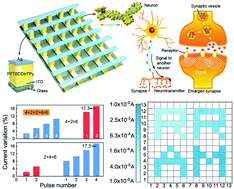Iridium-based polymer for memristive devices with integrated logic and arithmetic applications†
Abstract
Memristors that possess massive memory capacity and outstanding processing efficiency concurrently are vitally important to surmount the limitation of Moore's law and traditional Von Neumann bottleneck. Specifically, memristors are capable of integrating various functionalities such as information storage and processing into just one unit to obtain high electrical performance and thereby satisfy the contemporary needs. Here, a multifunctional polymer memristor with combined data storage and processing abilities on the basis of novel solution-processed poly(9,9-dioctyl-9H-fluorene)-alt-1,3-bis(2-ethylhexyl)-(5,7-di(thiophen-2-yl)-4H,8H-benzo[1,2-c:4,5-c′]dithiophene-4,8-dione)-alt-((2,4-pentanedionato)bis(2-(thiophen-2-yl)-pyridine)iridium) (PFTBDD-IrTPy) is demonstrated for the first time. As confirmed by field-emission scanning electron microscopy (FE-SEM), energy dispersive X-ray spectroscopy (EDX) as well as density functional theory (DFT) calculations, the memristive behavior of the multifunctional device is attributed to the synergetic electrochemical metallization and charge transfer effect. Associated with these cation regulating and charge transfer characteristics, our polymer memristor is capable of achieving diverse functionalities comprising multilevel data storage, biological synaptic emulation, Boolean logic function as well as basic arithmetic operations and commutative law of addition, subtraction, multiplication and division. These experimental results will accelerate the development of metal complex polymer based memristors for various electronic applications.



 Please wait while we load your content...
Please wait while we load your content...